|
 |
Louvre-DNP Museum Lab Customer Center
Tel: +81 (0) 35435 0880, Monday to Friday, 9 a.m. to 6 p.m. Closed on Saturday,Sundays and public holidays. |
|
 |
|
 |
 |
| Born of the combined know-how of the Musée du Louvre and Dai Nippon Printing, the Louvre-DNP Museum Lab is a platform for privileged reflection on museographic mediation tools. Each new presentation introduces novel multimedia devices. The Sixth Presentation plays host to new offerings on the themes outlined below. |
 |
 |
 |
 |
Enhancing the functions of conventional mediation tools through multimedia |
 |
 |
|
 |
| Ever seeking to make the mediation tools used in museums even more intuitive and user-friendly, Museum Lab has developed a new offering based on the principle of specimen boxes. By pushing a screen from front to back set on a specimen box that reconstructs the materials used to produce the works, visitors launch an animation sequence that provides a step-by-step breakdown of the creative process. Taking its cue from tools already familiar to visitors, this easy-to-operate device is designed to make curatorial explanations easier to follow. |
 |
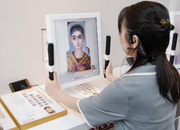 |
|
 |
 |
 |
 |
Discovering and understanding "hidden facts" more easily by visualizing scientific data |
 |
 |
|
 |
It is not easy to represent or explain the often highly technical results of scientific investigations using X-rays or ultraviolet analysis. In one respect, Museum Lab proposes their visual presentation in the form of super high-definition images in order to let visitors experience how researchers reveal an artwork's "hidden facts," as keys to a better understanding.
Moreover, through interactive reconstructions, the advanced digital imagery technology used at Museum Lab makes it possible to view the full production process, by digitally deconstructing and reconstructing layer by layer the various pictorial levels that are usually imperceptible to the naked eye.
Visitors are thereby able to understand the work's material composition in concrete terms. |
 |
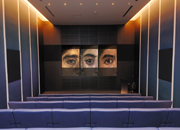 |
|
 |
 |
 |
 |
Enjoying a large corpus of works in a limited space |
 |
 |
|
 |
What form can multimedia take in an exhibition context?
Museum Lab has tried to answer this question of vital importance to museums by offering to reconstruct a large corpus of works in a limited space.
The projection of a recurring sequence of actual-size artworks on a big screen allows visitors to apprehend the full wealth and diversity of the works represented. Moreover, as there is a limit to the number of works that can be displayed in a museum gallery, multimedia provides a means of bringing together large groups of works for purposes of comparison, while also affording a coherent overview. |
 |
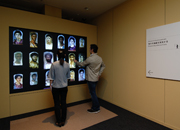 |
|
 |
 |
 |
 |
Providing information according to the level of visitor interest |
 |
 |
|
 |
The sixth presentation explores various ways of providing information to visitors commensurate with what spontaneously interests them.
One system offers a means of displaying artworks that reconciles the desire for an overview thanks to a large screen, with that of being able to take a closer look at a work, with enlargements thanks to the small rear projectors on a multi-screen technology.
A second display allows visitors the freedom to trace a work with their fingers for a closer examination and to enlarge the details. This recalls the sensation of using a magnifying glass—the system enlarges only the detail of interest in the actual-size image displayed, thus maintaining the sense of the work’s size and overall state.
|
 |
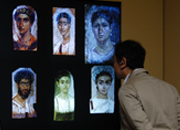

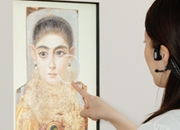 |
|
 |
 |
 |
 |
A guidance system designed to deal with both transmitting and receiving information |
 |
 |
|
 |
From the outset, Museum Lab has striven relentlessly to make multimedia handsets into safe and reliable guidance partners, able to offer a rich museum experience through their large range of functions. The aim is to provide a system able both to transmit and receive information for an optimal visit experience, and to exploit to the full a visual or audio offering according to the message and information that the museum wishes to circulate.
Audio displays in Museum Lab are activated automatically when someone enters a designated area. The system also makes it possible for a group of people to look at the same screen while listening to the commentary individually in the language of their choice. As such, it provides a glimpse of useful applications for a real museum environment, such as conveying general information about the museum or emergency procedures in a uniform fashion to all visitors.
In addition, for the sixth presentation, all of the multimedia handsets are equipped with image recognition technology in order to offer more extensive visitor assistance. By using the handset's camera to photograph the pictogram found near each display, visitors can obtain information on the way it works in the form of synthesized images, animations, or texts superimposed on images of the actual environment. |
 |
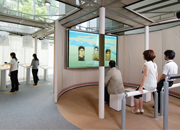

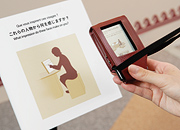 |
|
 |
 |
 |
 |
Encouraging visitors to think about their own relationship to the works |
 |
 |
|
 |
The sixth presentation continues to explore the line taken in the previous presentation prompting visitors to consider how the works relate to themselves. Throughout the course of the visit, the scenography has sought to arouse visitors' interest and curiosity, encouraging their active participation in the exhibition by asking for their interpretation of the work on display.
This time, the Website, current presentation and its various activities invite visitors to ponder the significance of "leaving behind a portrait of oneself." The aim is to interest them not only in the works exhibited, but also in their own perception. |
 |
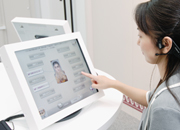 |
|
|

